National costume 各国民族服装英文介绍
- 格式:ppt
- 大小:2.34 MB
- 文档页数:18
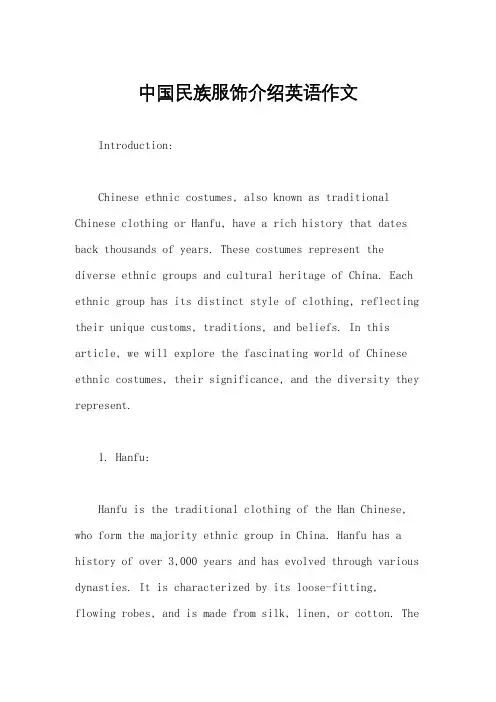
中国民族服饰介绍英语作文Introduction:Chinese ethnic costumes, also known as traditional Chinese clothing or Hanfu, have a rich history that dates back thousands of years. These costumes represent the diverse ethnic groups and cultural heritage of China. Each ethnic group has its distinct style of clothing, reflecting their unique customs, traditions, and beliefs. In this article, we will explore the fascinating world of Chinese ethnic costumes, their significance, and the diversity they represent.1. Hanfu:Hanfu is the traditional clothing of the Han Chinese, who form the majority ethnic group in China. Hanfu has a history of over 3,000 years and has evolved through various dynasties. It is characterized by its loose-fitting, flowing robes, and is made from silk, linen, or cotton. Thestyle and design of Hanfu vary depending on the gender, social status, and occasion.For men, Hanfu typically consists of a robe, a long skirt, and a sash. The robe is often adorned with intricate embroidery and exquisite patterns. Women's Hanfu, on the other hand, includes a long, flowing dress called a Ruqun, which consists of an upper garment and a skirt. The Ruqun can be further embellished with accessories such as a waistband, a shawl, and a headdress.Hanfu represents the elegance, grace, and modesty of ancient Chinese culture. It is often worn duringtraditional festivals, weddings, and other formal occasions to showcase the wearer's respect for tradition and their cultural identity.2. Tibetan Costume:Tibetan costumes are unique and distinct, reflecting the rich cultural heritage of the Tibetan people. The traditional Tibetan costume for men is called a "Chuba." Itis a loose, long-sleeved robe made of wool or silk. The Chuba is often adorned with colorful patterns and intricate designs. Men also wear a waistband and a hat called a "Tsepa" to complete their traditional attire.Women's traditional Tibetan costume is called a "Chuba" as well, but it is more elaborate and vibrant compared to men's. It consists of a long, flowing dress with a widebelt around the waist. The dress is often made of silk and is adorned with intricate embroidery, vibrant colors, and traditional Tibetan motifs. Women also wear various accessories like jewelry, headdresses, and aprons to enhance their traditional look.Tibetan costumes are not only worn on special occasions but are also a part of daily life. They represent the Tibetan people's strong connection to their culture, religion, and natural surroundings.3. Uygur Costume:Uygur costumes are an integral part of the Uygur ethnicgroup's cultural identity in China. The Uygur people, who primarily reside in the Xinjiang Uygur Autonomous Region, have a unique and diverse clothing style influenced bytheir nomadic heritage and Islamic traditions.Uygur men traditionally wear long, loose-fitting robes made of silk or cotton. The robe is often paired with loose trousers and a hat. The colors and patterns of their clothing represent their cultural and religious beliefs. Uygur women wear vibrant, long-sleeved dresses called "Atlas" or "Kemis." These dresses are made of silk and are adorned with intricate embroidery and vibrant patterns. Women also wear a headdress, usually made of silk, which is decorated with beads, feathers, and other ornaments.Uygur costumes are not only visually appealing but also reflect the Uygur people's history, lifestyle, andreligious practices. They are often worn during festivals, weddings, and other celebrations to showcase their cultural pride and identity.4. Zhuang Costume:The Zhuang ethnic group, one of the largest minority groups in China, has its unique traditional costumes that reflect their rich cultural heritage. Zhuang costumes are known for their vibrant colors, intricate embroidery, and exquisite craftsmanship.Zhuang men traditionally wear a collarless jacket, loose trousers, and a headscarf. The jacket is often made of silk or cotton and is adorned with colorful embroidery. Women's traditional Zhuang costume, known as "Luozhuang," is even more elaborate. It consists of a jacket, a long skirt, and an apron. The jacket and skirt are often made of silk and are embellished with intricate embroidery, silver ornaments, and colorful ribbons.Zhuang costumes are not only worn on special occasions but are also a part of the Zhuang people's daily life. They represent their cultural pride, social status, and their connection to their ancestors and nature.Conclusion:Chinese ethnic costumes, with their diverse styles, designs, and cultural significance, are a testament to the rich heritage and diversity of China's ethnic groups. Each costume represents a unique blend of history, tradition, and cultural identity. Whether it's the elegant Hanfu, the vibrant Tibetan costume, the Islamic-influenced Uygur costume, or the intricate Zhuang costume, these traditional attires showcase the beauty and cultural pride of the Chinese people. Preserving and promoting these costumes is crucial in maintaining the cultural diversity and heritage of China.。
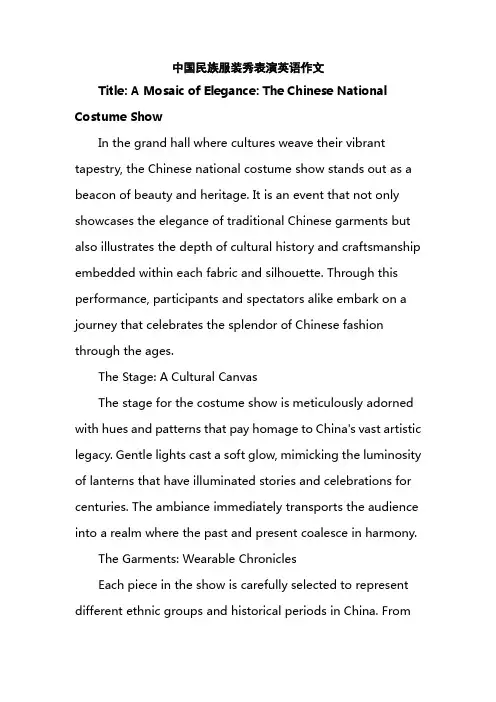
中国民族服装秀表演英语作文Title: A Mosaic of Elegance: The Chinese National Costume ShowIn the grand hall where cultures weave their vibrant tapestry, the Chinese national costume show stands out as a beacon of beauty and heritage. It is an event that not only showcases the elegance of traditional Chinese garments but also illustrates the depth of cultural history and craftsmanship embedded within each fabric and silhouette. Through this performance, participants and spectators alike embark on a journey that celebrates the splendor of Chinese fashion through the ages.The Stage: A Cultural CanvasThe stage for the costume show is meticulously adorned with hues and patterns that pay homage to China's vast artistic legacy. Gentle lights cast a soft glow, mimicking the luminosity of lanterns that have illuminated stories and celebrations for centuries. The ambiance immediately transports the audience into a realm where the past and present coalesce in harmony.The Garments: Wearable ChroniclesEach piece in the show is carefully selected to represent different ethnic groups and historical periods in China. Fromthe intricate embroidery of the Hanfu, symbolizing the cultural peak of ancient dynasties, to the bold colors and patterns of minority attire, every costume tells a unique story. The performers' graceful strides and elegant poses bring these garments to life, revealing not just the aesthetic value but also the practical wisdom behind each design.The Performance: A Dance of Threads and TimeAs traditional Chinese music fills the air, performers step onto the stage, clothed in regalia that has been passed down through generations. Their movements are not mere catwalk strides but a choreographed narrative that weaves together elements of classical Chinese dance. Each twirl and gesture is imbued with meaning, drawing parallels between the fluidity of silk and the resilience of the Chinese people.The Audience: Connecting Threads Across ContinentsSpectators from around the globe witness not just a display of clothing but a profound cultural exchange. With each passing moment, the audience becomes more than mere observers; they become participants in a celebration that transcends borders. The show evokes feelings of nostalgia for some, curiosity for others, and admiration for all. It is a testament to the universal language of beauty and the sharedspirit of humanity.Conclusion: Unfolding Common TapestryAs the final notes of the music fade and the last performer bows, the resonating applause signifies more than just the conclusion of a successful show. It acknowledges the shared experience—the understanding that fashion is more than fabric; it is the physical manifestation of culture, history, and communal identity. The Chinese national costume show does not merely exhibit attire; it unfolds a common tapestry woven with threads of diversity, enriching the global mosaic with its distinctive colors and patterns.Reflecting on your own encounters with cultural performances, what emotions or insights have been sparked by such events? How can these experiences foster a greater appreciation for the world's cultural richness?。
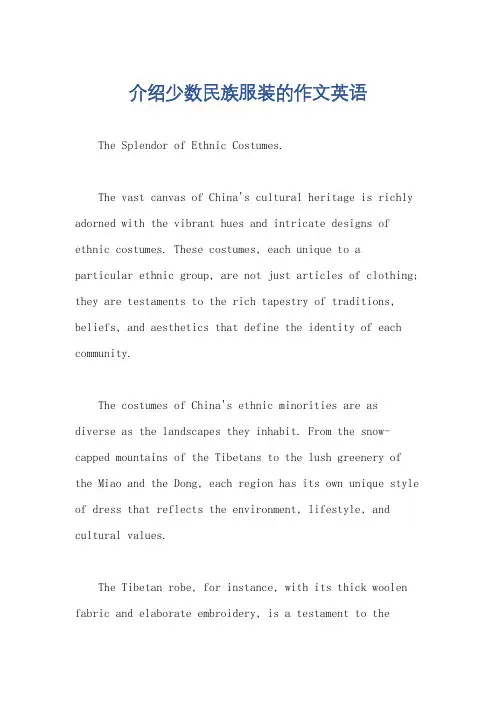
介绍少数民族服装的作文英语The Splendor of Ethnic Costumes.The vast canvas of China's cultural heritage is richly adorned with the vibrant hues and intricate designs of ethnic costumes. These costumes, each unique to aparticular ethnic group, are not just articles of clothing; they are testaments to the rich tapestry of traditions, beliefs, and aesthetics that define the identity of each community.The costumes of China's ethnic minorities are as diverse as the landscapes they inhabit. From the snow-capped mountains of the Tibetans to the lush greenery of the Miao and the Dong, each region has its own unique style of dress that reflects the environment, lifestyle, and cultural values.The Tibetan robe, for instance, with its thick woolen fabric and elaborate embroidery, is a testament to theharsh climes of the Himalayas. The vibrant blues and redsof the robe not only keep the wearer warm but also serve as a symbol of their strong spiritual beliefs. Similarly, the Hui's traditional long coats and hats, with their Islamic influence, exude a sense of modesty and piety.The Miao and Dong women, known for their intricatesilver jewelry and brightly colored dresses, wear costumes that are as elaborate as they are functional. The intricate patterns and designs on their dresses are often passed down through generations, serving as a form of oral history anda testament to their rich cultural heritage.The costumes of the Mongolians, with their distinctive fur trim and wide sleeves, reflect the nomadic lifestyle of this ethnic group. Their clothing is designed to withstand the rigors of the steppe, while also serving as a symbol of their proud warrior heritage.The Uyghurs, with their distinctive hats and long, flowing robes, exude a sense of elegance and sophistication. Their costumes, often made from silk and other luxuriousfabrics, are a testament to their rich cultural heritage and their status as traders and merchants on the Silk Road.The influence of these ethnic costumes can be seen in various aspects of Chinese culture, from art and music to dance and theater. The vibrant colors and intricate designs of these costumes have also influenced fashion trends in modern China, with many designers incorporating ethnic elements into their collections.In conclusion, the costumes of China's ethnicminorities are not just articles of clothing; they are cultural icons that represent the rich diversity and unique identity of each ethnic group. They are a testament to the resilience and adaptability of these communities, who have preserved their traditions and values through the ages. As we celebrate the beauty and splendor of these costumes, we also pay tribute to the hardworking craftsmen and women who have spent generations perfecting their skills and keeping these traditions alive.。

民族风情,华服之美——中国民族服装秀表演英语作文The stage was ablaze with vibrant colors and intricate designs as the National Ethnic Costume Show unfolded. It was a vibrant tapestry of China's rich cultural heritage, where each garment spoke volumes about the diverse traditions and histories of its respective ethnic group.The show began with a flourish, as models gracefully strode onto the stage, clad in the exquisite costumes of the Han nationality. The elegance of the silken gowns and the intricate embroidery on the sleeves and hemlines were a testament to the sophistication of Han culture. The colors were muted yet vibrant, reflecting the harmony and balance that is synonymous with the Han people.As the show progressed, the audience was treated to a visual feast of costumes from various ethnic groups across China. The robust and earthy hues of the Mongolian costumes stood out, with their heavy use of fur and leather, reflecting the harsh yet beautiful landscapes of the Mongolian steppes. The graceful and feminine costumes of the Uyghur people, adorned with intricate beadwork andsequins, were a stark contrast to the masculine and robust attire of the Tibetan men, who wore robes adorned with elaborate patterns.The show also highlighted the vibrant and colorful costumes of the Zhuang, Miao, and Yi ethnic groups. The bright hues and intricate patterns of their costumes were a testament to the creativity and artistry of these cultures. The costumes were not just clothing; they were a means of expression, a way to celebrate and honor one's heritage and identity.The finale of the show was a grand display of all the costumes together, as models paraded down the runway, each representing a unique ethnic group. It was a powerful reminder of the rich tapestry of China's cultural diversity, where each ethnic group contributes its unique flavors and hues to create a vibrant and colorful nation.The National Ethnic Costume Show was not just a fashion extravaganza; it was a celebration of China's cultural diversity and unity. It reminded us that despite our differences, we are all united by a common thread ofhistory and heritage, and that our diverse cultures are what make China truly unique and beautiful.**民族风情,华服之美——中国民族服装秀表演** 民族服装秀拉开了序幕,舞台上五彩斑斓、设计精巧的服装熠熠生辉,呈现出一幅幅中华民族丰富文化遗产的生动画面。
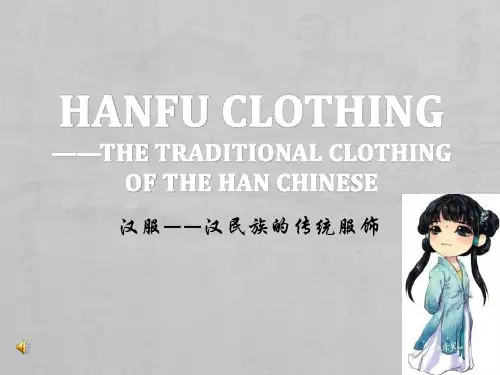
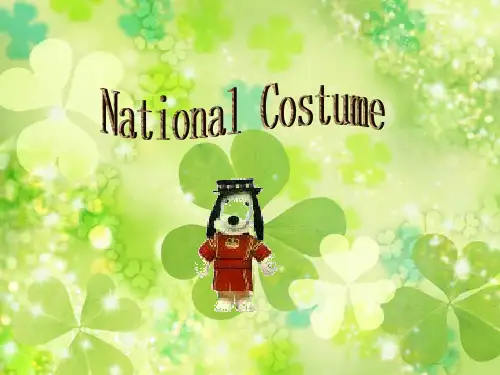
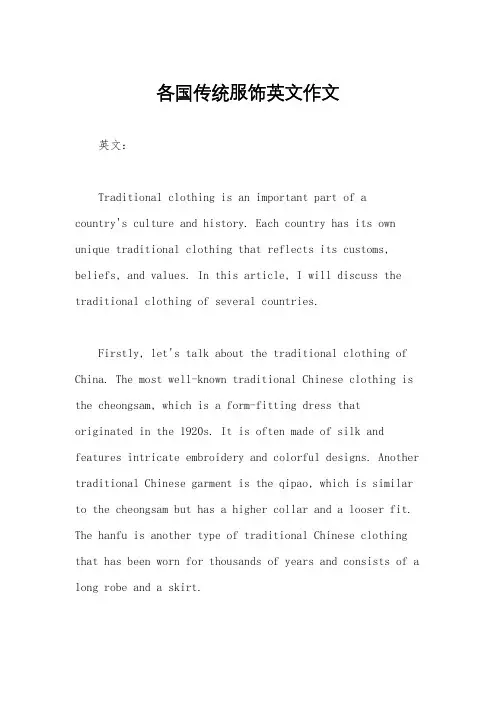
各国传统服饰英文作文英文:Traditional clothing is an important part of acountry's culture and history. Each country has its own unique traditional clothing that reflects its customs, beliefs, and values. In this article, I will discuss the traditional clothing of several countries.Firstly, let's talk about the traditional clothing of China. The most well-known traditional Chinese clothing is the cheongsam, which is a form-fitting dress thatoriginated in the 1920s. It is often made of silk and features intricate embroidery and colorful designs. Another traditional Chinese garment is the qipao, which is similar to the cheongsam but has a higher collar and a looser fit. The hanfu is another type of traditional Chinese clothing that has been worn for thousands of years and consists of a long robe and a skirt.Next, let's look at the traditional clothing of Japan. The kimono is the most iconic piece of traditional Japanese clothing. It is a long, flowing robe that is often made of silk and features elaborate designs and patterns. The yukata is a lighter and more casual version of the kimono that is worn in the summer. Another traditional Japanese garment is the hakama, which is a type of wide-legged pants that were originally worn by samurai.Moving on to India, the traditional clothing is incredibly diverse and varies depending on the region and occasion. The saree is perhaps the most well-known traditional Indian garment. It is a long piece of fabric that is draped around the body and can be worn in many different styles. The salwar kameez is another popular traditional Indian outfit that consists of a long tunic and loose pants. The dhoti is a type of garment that is worn by men and consists of a long piece of cloth that is wrapped around the waist.In Africa, traditional clothing also varies greatly depending on the region and culture. The dashiki is a typeof shirt that is commonly worn in West Africa. It is often made of bright, colorful fabric and features intricate patterns. The kaftan is another traditional African garment that is worn by both men and women. It is a long, loose-fitting robe that is often made of cotton or silk.In conclusion, traditional clothing is an importantpart of a country's culture and history. Each country hasits own unique traditional clothing that reflects its customs, beliefs, and values. By wearing traditional clothing, people can connect with their cultural heritage and celebrate their identity.中文:传统服饰是一个国家文化和历史的重要组成部分。
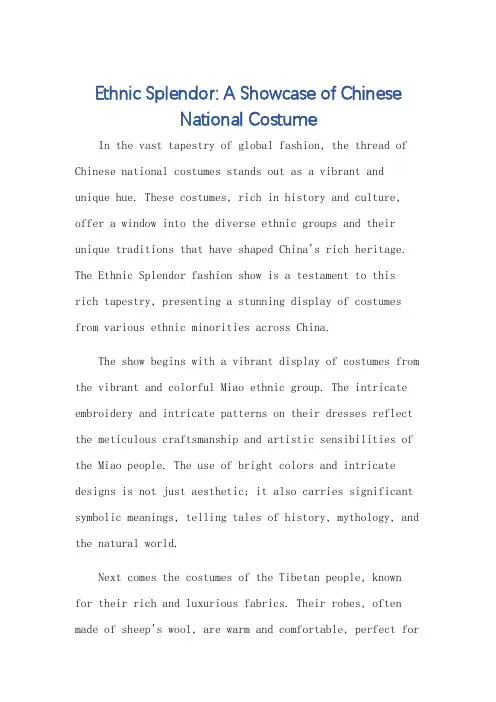
Ethnic Splendor: A Showcase of ChineseNational CostumeIn the vast tapestry of global fashion, the thread of Chinese national costumes stands out as a vibrant and unique hue. These costumes, rich in history and culture, offer a window into the diverse ethnic groups and their unique traditions that have shaped China's rich heritage. The Ethnic Splendor fashion show is a testament to thisrich tapestry, presenting a stunning display of costumes from various ethnic minorities across China.The show begins with a vibrant display of costumes from the vibrant and colorful Miao ethnic group. The intricate embroidery and intricate patterns on their dresses reflect the meticulous craftsmanship and artistic sensibilities of the Miao people. The use of bright colors and intricate designs is not just aesthetic; it also carries significant symbolic meanings, telling tales of history, mythology, and the natural world.Next comes the costumes of the Tibetan people, knownfor their rich and luxurious fabrics. Their robes, often made of sheep's wool, are warm and comfortable, perfect forthe cold climes of the Tibetan plateau. The intricate designs and patterns on these robes, often embroidered with gold or silver threads, are a testament to the skilled craftsmanship of Tibetan weavers.The Han Chinese, the largest ethnic group in China, also have a rich and diverse wardrobe. From the elegant qipao for women to the stylish Changshan for men, the Han costumes exude a sense of classic elegance and refinement. These costumes, often made of silk or satin, are a testament to the sophistication and elegance of Han Chinese culture.The Ethnic Splendor fashion show also features costumes from other ethnic groups such as the Hui, the Zhuang, and the Yi, each with their unique designs and patterns. These costumes, often adorned with beads, sequins, and other embellishments, are a visual feast, showcasing thediversity and richness of Chinese ethnic fashion.The beauty of Chinese national costumes lies not just in their aesthetic appeal but also in their ability to tell stories, to preserve history, and to honor the traditions of each ethnic group. These costumes are not just clothing;they are cultural icons, symbols of identity, and a bridge between the past and the present.In conclusion, the Ethnic Splendor fashion show is a celebration of diversity, a testament to the rich tapestry of Chinese ethnic fashion. It is a reminder of the beauty and uniqueness of Chinese culture and a celebration of the diverse ethnic groups that have shaped it. This show not only showcases the stunning costumes but also preserves the history and traditions of these ethnic groups, ensuringthat their rich heritage is passed down to future generations.**民族华彩:中国民族服装秀**在全球时尚的丰富画卷中,中国民族服装以其独特而富有活力的色彩脱颖而出。
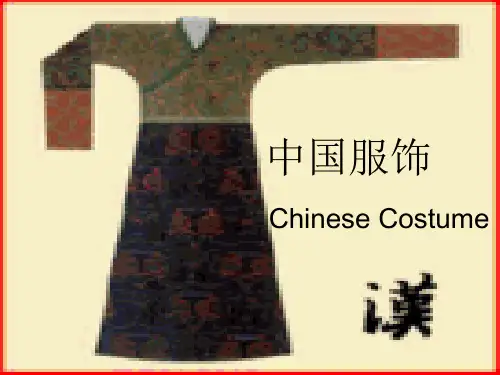
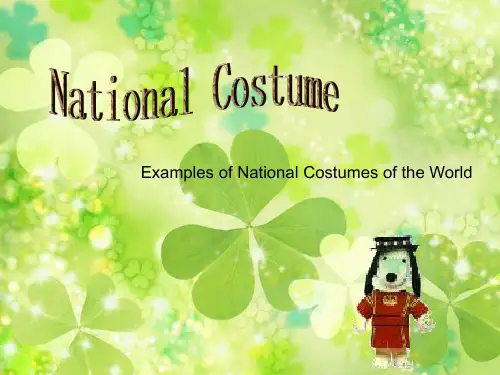
![各国传统服装英文[1]](https://uimg.taocdn.com/a5368655102de2bd960588b8.webp)
各地特色服装介绍英文作文英文:When it comes to traditional clothing, every region has its own unique style. In China, for example, the qipao is a classic dress that originated in Shanghai and is now worn by women all over the country. It is a form-fitting dress with a high collar and slit on the side, often made of silk or other luxurious fabrics. The qipao is a symbol of elegance and femininity.In India, the sari is a traditional garment worn by women. It is a long piece of fabric draped over the body in a variety of ways, depending on the region and occasion. The sari is often made of silk or cotton, and comes in a wide range of colors and patterns. It is a versatile and beautiful garment that can be worn for both formal and casual occasions.In Japan, the kimono is a traditional garment that hasbeen worn for centuries. It is a long robe with wide sleeves and a sash, often made of silk or other high-quality fabrics. The kimono comes in many different styles and patterns, and is worn by both men and women. It is a symbol of Japanese culture and tradition.In the United States, there are many different types of traditional clothing depending on the region. For example, in the southern states, many people wear cowboy boots and hats, while in New England, people wear preppy clothinglike khakis and polo shirts. In Hawaii, the traditional garment is the muumuu, a loose-fitting dress made of cotton or other lightweight fabrics. Each region has its own unique style that reflects its history and culture.中文:说到传统服装,每个地区都有自己独特的风格。
Traditional Costume of Han NationalityWhen I wanted to introduce the Han nationality; When intended to give publicity for the Han nationality; When I saw the 56 ethnic groups take photos together, I always thought about what is our national costume?What is the traditional costume of the Han nationality? Is that Cheongsam? Tang suit? Or just reluctantly say that,” sorry, we don’t have traditional costume”? Of course no!Our name is Han. Our language is Chinese. Our word is the Chinese characters. And then, if there is a kind of clothing that only belongs to the Han nationality, it must be Hanfu, without a doubt!Hanfu exist in Han culture and Han people’s life for more than 3000 years until the ruler of Qing-dynasty forced Han people to give up there traditional costume.In ancient China, both men and women only wore clothes that overlap the right side to the left side. The opposite right-over-left style is for other nations. For Han people, right-over-left style meant death.There are many kind of Hanfu, like Shenyi, which could wear on Chinese holiday or some importantceremonies. The Zhiduo was worn by men. It was popular among scholar in Ming Dynasty. In addition, the Ruqun, Zhaoshan, Duanda are general style of Hanfu.Nowadays, most people know about Japanese Kimono and Korean Hanbok, but few of them know that they were both created based on the styles of Hanfu. What a big irony!。